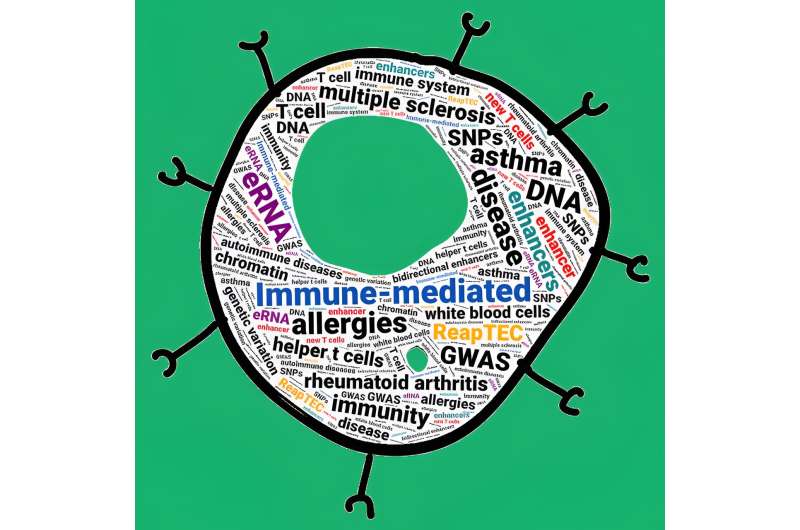This article has been reviewed according to Science X's editorial process and policies. Editors have highlighted the following attributes while ensuring the content's credibility:
fact-checked
peer-reviewed publication
trusted source
proofread
Scientists discover new T cells and genes related to immune disorders

Researchers led by Yasuhiro Murakawa at the RIKEN Center for Integrative Medical Sciences (IMS) and Kyoto University in Japan and IFOM ETS in Italy have discovered several rare types of helper T cells that are associated with immune disorders such as multiple sclerosis, rheumatoid arthritis, and even asthma.
Published in Science, the discoveries were made possible by a newly developed technology they call ReapTEC, which identified genetic enhancers in rare T cell subtypes that are linked to specific immune disorders. The new T cell atlas is publicly available and should help in the development of new drug therapies for immune-mediated diseases.
Helper T cells are a kind of white blood cell that make up a large part of the immune system. They recognize pathogens and regulate the immune response. Many immune-mediated diseases are caused by abnormal T cell function. In autoimmune diseases like multiple sclerosis, they mistakenly attack parts of the body as if they were pathogens.
In the case of allergies, T cells overreact to harmless substances in the environment like pollen. We know of several common T cells, but recent studies have shown that rare and specialized types of T cells exist, and they might be related to immune-mediated diseases.
Within all cells, including T cells, there are regions of DNA called "enhancers." This DNA does not code for proteins. Instead, it codes for small pieces of RNA, and enhances the expression of other genes. Variations in T cell enhancer DNA therefore lead to differences in gene expression, and this can affect how T cells function. Some enhancers are bidirectional, which means that both strands of the DNA are used as templates for enhancer RNA.
The researchers from several different laboratories at RIKEN IMS, as well as colleagues at other institutes, teamed up to develop the new ReapTEC technology and look for connections between bidirectional T cell enhancers and immune diseases.
After analyzing about a million human T cells, they found several groups of rare T cell types, accounting for less than 5% of the total. Applying ReapTEC to these cells identified almost 63,000 active bidirectional enhancers. To determine whether any of these enhancers are related to immune diseases, they turned to genome-wide association studies (GWAS), which have reported numerous genetic variants, called single-nucleotide polymorphisms, that are related to various immune diseases.
When the researchers combined the GWAS data with the results of their ReapTEC analysis, they found that genetic variants for immune-mediated diseases were often located within the bidirectional enhancer DNA of the rare T cells that they had identified. In contrast, genetic variants for neurological diseases did not show a similar pattern, meaning that the bidirectional enhancers in these rare T cells are related specifically to immune-mediated diseases.
Going even deeper into the data, the researchers were able to show that individual enhancers in certain rare T cells are related to specific immune diseases. Overall, among the 63,000 bidirectional enhancers, they were able to identify 606 that included single-nucleotide polymorphisms related to 18 immune-mediated diseases.
Lastly, the researchers were able to identify some of the genes that are the targets of these disease-related enhancers. For example, when they activated an enhancer that contained a genetic variant related to inflammatory bowel disease, the resulting enhancer RNA triggered upregulation of the IL7R gene.
"In the short-term, we have developed a new genomics method that can be used by researchers around the world," says Murakawa. "Using this method, we discovered new types of helper T cells as well as genes related to immune disorders. We hope that this knowledge will lead to a better understanding of the genetic mechanisms underlying human immune-mediated diseases."
In the long-term, the researchers believe follow-up experiments will be able to identify new molecules that can be used to treat immune-mediated diseases.
More information: Akiko Oguchi et al, An atlas of transcribed enhancers across helper T cell diversity for decoding human diseases, Science (2024). DOI: 10.1126/science.add8394. www.science.org/doi/10.1126/science.add8394




















